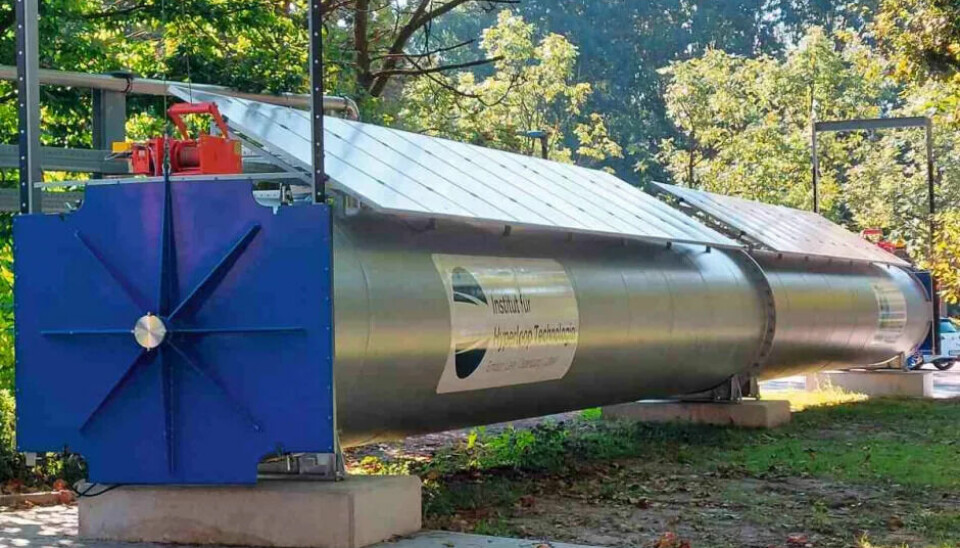From research
University accelerates in Hyperloop research

Emden/Leer University has made a significant step in Hyperloop research with the opening of the goTube test tube.
The exploration of hyperloop technology at the University of Applied Sciences Emden/Leer is making significant progress: the new 'goTube' test tube was officially opened on the Emden campus by the Lower Saxony Minister for Science and Culture, Falko Mohrs. This paves the way for new
technological insights that can also advance research in this field beyond the region.
With development projects and measurements in the low-pressure tube, the team of the university's own hyperloop institute will focus on various technical aspects, providing exciting practical insights for students in-house, and sharing important findings for joint research with European and international partners.
Support for hyperloop
“There is now great interest across Europe in advancing hyperloop technology,” says Prof. Dr.-Ing. Thomas Schüning, who heads the institute together with Prof. Dr. Walter Neu. Last year, EU Commission President Ursula von der Leyen tasked her transport commissioner with “proposing a strategy to promote and develop cutting-edge technologies like hyperloop” to enable Europe to take a leading role in innovative transport concepts of the future.
Pneumatic tube for passengers
The Hyperloop transport system involves a technology where a transport capsule, also called a pod, is propelled through a low-pressure tube at speeds of up to 700 kilometres per hour. This is made possible by magnetic levitation technology. The test infrastructure for magnetic levitation technology located in Lathen offers a perspective for a future European technology and certification centre for the Hyperloop.
In the 27-metre-long steel tube 'goTube' with a diameter of 1.6 metres, the focus in Emden is on propulsion technologies, vacuum technology, the thermal stability of system components, and material properties. The research infrastructure enables a variety of technology developments and validation for logistics applications.
Students are intensively involved in the further development of Hyperloop technology. “This longest research infrastructure in Germany will enable us to elevate our research activities to a new level and thus initiate further innovative projects,” says Prof. Dr. Walter Neu.
Germany's longest Hyperloop facility
The goTube steel tube on the Emden campus, at 27 metres, is the longest Hyperloop facility in Germany. According to Lower Saxony's Minister of Science, Falko Mohrs, these are “possibly among the most important metres on the way to a high-speed transport system of the future.”
On behalf of the minister, who had to cancel his visit to Emden at short notice due to important coalition negotiations in Berlin, Rüdiger Eichel conveyed congratulations and words of appreciation on the occasion of the opening as head of the department for research, innovation and Europe in the ministry of science. Representatives from state and EU politics as well as from industry and science were also present. This included the project partners of the recently launched EU project Hyper4Rail from all over Europe, who concluded a week-long workshop at the university with the inauguration.
Europe-wide mobility research
With the steel tube installed in Emden, the team from the university's institute for hyperloop technology is working in current technology areas of Europe-wide mobility research.
These development projects are also integrated into teaching. A rail-guided vehicle is driven by a linear motor or integrated drive in the vacuum of the tube. The focus of the investigations is on drive and control technology, vacuum technology, thermal stability of system components,
material properties of the infrastructure as well as logistics and operational concepts.
The experiences gained will be incorporated into the Hyper4Rail project, in which the university is significantly involved. “The aim is to define uniform standards across Europe for the implementation of Hyperloop technology,” say Professors Dr Walter Neu and Dr Thomas Schüning.
Strong boost for research
This also finds receptive ears in the state of Lower Saxony. “Environmentally friendly and energy-efficient high-speed mobility: at the University of Emden/Leer, this vision is becoming a bit more of a reality,” is the message from Minister Mohrs.
The goTube test tube exemplifies how research can lead to practical applications “that can make all our lives better.” In close cooperation with their partners, the university has developed into an important location for Hyperloop research. The investment by the state of Lower Saxony and the EU gives this research focus another strong boost. The costs for the goTube amount to around one million euros so far.
Anything but a standard project
After the delivery of the steel tubes from Mannesmann Großrohr, Salzgitter, the equipment and installation were carried out by the steel construction company Klaas Siemens in Emden.
As a university infrastructure, the goTube falls under the remit of the State Building Management, which is responsible for all university buildings. "The construction of the goTube was anything but a standard project," said Maike Middelkampf, regional director at the State Building Management Region North-West. "Thanks to careful planning and the very good cooperation with the university, we have created a unique research infrastructure in Emden."